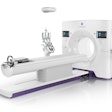Dear Cardiac Imaging Insider,
Diabetic patients are known to have high rates of coronary artery disease, but a new study from Denmark shows that many diabetics have impaired coronary flow reserve (CFR) as well, meaning their ability to supply more blood and oxygen to the myocardium when needed is severely restricted.
CFR is a serious condition and an important predictor of cardiac mortality. The investigators used PET/CT with a rubidium-82 tracer for its ability to measure perfusion combined with the anatomic accuracy of CT. The investigators found two risk factors, both common to diabetics, that were associated with the condition. Get the rest of the story here.
Meanwhile, a study in Ultrasound Medicine and Biology features a new, minimally invasive heart catheter that could challenge radiofrequency (RF) ablation in the removal of abnormal cells that cause the heart's electrical signal to malfunction. Current RF techniques are limited to transmural lesions, while a fully ultrasound-based system has the potential to detect deep lesions by means of local harmonic motion (LHM) imaging, an elastography technique that uses both therapeutic and diagnostic ultrasound transducers to estimate and image harmonic motion in tissues, overcoming the tissue depth limitations of current RF techniques.
In France, researchers are using shear-wave elastography to improve the accuracy of RF ablation procedures to treat cardiac arrythmias. They have developed a transesophageal device that can deliver high-intensity focused ultrasound and shear-wave elastography, which has some advantages over gold-standard MRI for ablation guidance.
In coronary plaque analysis, optical coherence tomography (OCT) significantly outperforms intravascular ultrasound for characterizing plaques, and in a new study, Italian investigators used OCT to analyze culprit lesions in patients with coronary plaque rupture and thin-cap fibroatheroma in patients with coronary artery disease, especially those with acute coronary syndromes. The study also looked at the principal risk factors for the often-fatal ruptures.
Finally, in coronary CT angiography, a new study from the U.K. offers important advice for radiologists looking to cut the radiation dose without having to implement iterative reconstruction technology. Radiologists from Portsmouth Hospitals National Trust Service have come up with several ways to do the job simply and effectively. Find out more here.
We invite you to scroll through the links below for the rest of the news in cardiac imaging, right here in your AuntMinnieEurope.com Cardiac Imaging Community.



















